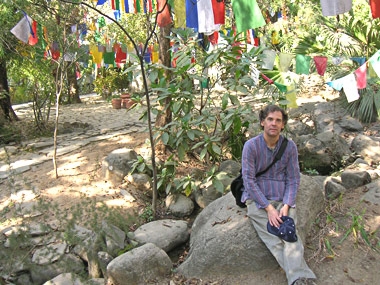From Asia to New Hampshire and Back

|
|
|
Jon Keenan under Tibetan prayer flags at the Norbulingka Art Institute in Dharamsala, Himachal Pradesh, in Northern India. |
Jon Keenan was a world traveler long before he came home to New Hampshire.
His diplomat father had family ties to Dover near the New Hampshire coast, but Jon was born in France and lived in India, Pakistan, Thailand and Washington, D.C., before returning to his roots for college at the University of New Hampshire. By then he had already been introduced to the fine art of several cultures.
“My father was a collector of Asian art,” Keenan says. “We visited museums and art dealers wherever we were stationed. Through those experiences—and the visiting artists we had at my schools—I developed an interest of my own.
Sparking a Career
“It was in India that I became interested in ceramics, through village potters demonstrating at the American International School I attended. It really captured my imagination, witnessing potters at work. The method was very primitive. They worked on the floor with a hand wheel that turns on massive wooden slab on ground and made beautiful amphora forms.
“In India, traditionally pottery is made by the lower classes and the Untouchables—village potters—making simple earthenware pieces for everyday use. There are estimated to be a million potters in India.
“On the trains in India, they serve teas out of handmade earthenware cups that are used and then thrown away. Pottery-making in India hasn't had the status that it deserves. Just now, you are beginning to have a studio art movement there. Other Asian cultures—Japan, China, Korea—respect ceramics as an art.”
Out of India, Into Japan
In college, Keenan's interests developed into serious study. “I always wanted to be a teacher, and I was fortunate to find a passion in Asian art history and studio art.” Fluent in Japanese, Keenan took a junior year abroad at Doshisha University in Kyoto. After graduation from UNH, he studied art history and ceramics at Kyoto University of Fine Arts Graduate School, where he completed a Master of Fine Arts degree in 1986.
Since 1990, Keenan has taught ceramics and Asian art history at Colby-Sawyer, where he served as chair of the Department of Fine and Performing Arts from 1997 to 2005. His ceramic work has been regularly and widely exhibited, from New England to New York City to Japan.
Keenan continues to travel frequently to study art and ceramic culture throughout the United States and Asia. During his sabbatical leave last year, he interviewed a ceramic artist in New Delhi who is part of India's emerging studio art movement and visited temples and museums in India, Japan, Thailand and the United States. He lectured at several institutions, including his old school in India and the Stanford Asian Studies Center in Kyoto. He also attended teachings by His Holiness the 14th Dalai Lama at his headquarters in Dharamsala, India.
Meanwhile, back in the United States, Keenan pursued a year-long research project at the University of California Los Angeles' Chemistry Department and Exotic Materials Institute. Keenan's work applied the cutting-edge field of nanotechnology to the field of art conservation as he worked on the development of surface treatments that would prevent environmental pollution from corroding---and eventually destroying--outdoor iron sculpture. Between trips, he spent time working in his Elkins, NH, studio.
Shared Paths
Keenan's relationship to his co-curator, Gerry Williams, goes back to the 1970s. They met at UNH during Keenan's freshman year. Over the years, they have worked, taught and exhibited together, and Keenan served for several years on the board of The Studio Potter, when Williams was editor. They share many social values and, later this year, will collaborate with Keenan's students on an “Empty Bowls” project to raise funds to fight world hunger.
They also have India in common.
“Gerry studied at a missionary school, known as Woodstock, in the foothills of the Himalayas,” Keenan says. “My school, American International School in Delhi, would travel and compete against his school in sporting events. Usually we were humbled in defeat! Like Gerry, too, I deeply respect the work of Mahatma Gandhi and I managed to visit his tomb in New Delhi this past winter.
“I respect Gerry's work and—definitely in terms of values and philosophy—see him as a model. His approach to his work, to living, is aligned with the way I feel, lead my life. Also, his approach to ceramics on a global scale parallel my own interests—the idea of a network, reaching out to other pottery communities, and supporting and promoting their work internationally.”
Some of Jon Keenan's new ceramic work will be on exhibit at the Kimball-Jenkins Estate in Concord, NH, from Oct. 5 - Nov. 3, 2006, and in the faculty review exhibition on campus in the late fall.


